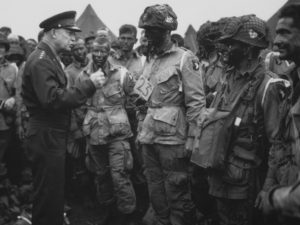June 5 in U.S. military history

1794: The first six officers of the new United States Navy receive their commissions: Captain John Barry (the first captain in the Continental Navy and considered the “father of the American Navy), Samuel Nicholson, Silas Talbot, Joshua Barney, Richard Dale, and Thomas Truxtun.
1917: The First Naval Aeronautical Detachment lands at Brest, France, becoming the first American military unit deployed for World War I. The Naval aviators, commanded by Lt. Kenneth Whiting, will conduct anti-submarine patrols throughout the war. The service collier USS Jupiter that carried the detachment across the Atlantic will be converted to the United States’ first aircraft carrier, USS Langley (CV-1) in 1920.
1944: As the sun sets on airfields across England, 13,328 American paratroopers with the 82d and 101st Airborne Divisions (along with nearly 8,000 British and Canadian paratroopers) board the C-47 transports and gliders that will carry them behind Nazi lines on “the Great Crusade.” 1,000 British bombers pound German defenses at the beaches of Normandy while thousands of ships carrying some 130,000 Allied soldiers steam towards France After months of planning, Operation Overlord is finally underway.
Meanwhile, the B-29 “Superfortress” flies its first combat mission. Bombers flying out of airfields in India attack Japanese rail lines and other targets in Bangkok, Thailand.
1945: On Okinawa, Marines capture the airfield on the Oroku Peninsula, while a typhoon damages nearly every ship at sea. Kamikaze attacks cripple the battleship USS Mississippi (BB-41) and the heavy cruiser USS Louisville (CA-28).
On Japan, 473 B-29 bombers drop some 3,000 tons of incendiary bombs on Kobe, destroying much of the city.
1948: A Northrop YB-49 “flying wing” experimental bomber crashes while conducting stall recovery tests at Muroc Air Force Base (now Edwards AFB – in honor of the YB-49’s copilot, Capt. Glen Edwards), killing all five airmen on board. The advanced warplane program will be scrapped, but designer Jack Northrop’s dream of a flying wing aircraft will become reality when Northrop’s B-2 stealth bomber makes its first flight 51 years later.